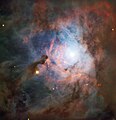Fitxategi:The Birth of the Hunter.jpg
- Fitxategia
- Fitxategiaren historia
- Irudira dakarten loturak
- Fitxategiaren erabilera orokorra
- Metadatuak

Bereizmen handikoa ((1.705 × 1.767 pixel, fitxategiaren tamaina: 708 KB, MIME mota: image/jpeg))
Fitxategi hau Wikimedia Commonsekoa da. Hango deskribapen orriko informazioa behean duzu. |
Laburpena
| DeskribapenaThe Birth of the Hunter.jpg |
English: The constellation of Orion (The Hunter) is one of the most recognisable collections of stars in the night sky. We have noted Orion’s prominent stars for tens of thousands of years at least, and likely far longer. Chinese astronomers called it 参宿 or Shēn, literally “three stars”, for its three bright dots (which form the Hunter’s belt). The ancient Egyptians regarded it as the gods Sah and Sopdet, manifestations of Osiris and Isis, respectively, whereas Greek astronomers saw a brave hunter — the eponymous Orion — with his sword above his head, ready to strike.
Mythology aside, Orion is a fascinating patch of sky. This image, from ESO's Very Large Telescope, shows a reflection nebula nestled at the heart of the constellation — NGC 2023. Located close to the well-known Horsehead and Flame Nebulae, NGC 2023 lurks about 1500 light-years away from Earth, and is one of the largest reflection nebulae in the sky. Reflection nebulae are clouds of interstellar dust that reflect the light from nearby or internal sources, like fog around a car headlight. NGC 2023 is illuminated by a massive young star named HD 37903. The star is extremely hot — several times hotter than the Sun — and its bright blue-white light causes NGC 2023’s milky glow. Such nebulae are often the birthplaces of stars, and contain a clumpy distribution of gas that’s significantly denser than the surrounding medium. Under the influence of gravity, these clumps attract one another and merge, eventually creating a new star. In a few million years time, Orion's Belt may gain a new star! The image was taken with the VLT’s FORS (FOcal Reducer and Spectrograph) instrument as part of the ESO Cosmic Gems programme. This initiative produces images of interesting and visually attractive objects using ESO telescopes, for the purposes of education and outreach. The programme makes use of telescope time that cannot be used for science observations. All data collected may also be suitable for scientific purposes, and are made available to astronomers through ESO’s science archive.Italiano: La costellazione di Orione (The Hunter) è uno degli asterismi più riconoscibili nel cielo notturno. Gli astronomi cinesi lo chiamarono 参 宿 o Shēn, letteralmente " tre stelle ", per i suoi tre punti luminosi (che formano la cintura del cacciatore). Gli antichi egizi lo consideravano come gli dei Sah e Sopdet, rispettivamente le manifestazioni di Osiride e Iside, mentre gli astronomi greci videro un coraggioso cacciatore - l'omonimo Orione - con la spada sopra la testa, pronto a colpire.
Mitologia a parte, Orione è un affascinante angolo di cielo. Questa immagine, dal Very Large Telescope dell'ESO , mostra una nebulosa a riflessione incastonata nel cuore della costellazione. Situata vicino alle Nebulose Testa di Cavallo e Fiamma, NGC 2023 dista circa 1500 anni luce dalla Terra, ed è una delle più grandi nebulose a riflessione nel cielo |
| Data | |
| Jatorria | https://www.eso.org/public/images/potw1919a/ |
| Egilea | ESO |
Lizentzia
 |
This media was created by the European Southern Observatory (ESO).
Their website states: "Unless specifically noted, the images, videos, and music distributed on the public ESO website, along with the texts of press releases, announcements, pictures of the week, blog posts and captions, are licensed under a Creative Commons Attribution 4.0 International License, and may on a non-exclusive basis be reproduced without fee provided the credit is clear and visible." To the uploader: You must provide a link (URL) to the original file and the authorship information if available. |
This file is licensed under the Creative Commons Attribution 4.0 International license.
| |
Irudi-oineko testuak
Fitxategi honetan agertzen diren itemak
honako hau irudikatzen du
13 maiatza 2019
Fitxategiaren historia
Data/orduan klik egin fitxategiak orduan zuen itxura ikusteko.
| Data/Ordua | Iruditxoa | Neurriak | Erabiltzailea | Iruzkina | |
|---|---|---|---|---|---|
| oraingoa | 17:22, 14 otsaila 2024 |  | 1.705 × 1.767 (708 KB) | C messier | full size |
| 10:39, 13 maiatza 2019 |  | 1.280 × 1.327 (195 KB) | Jmencisom | User created page with UploadWizard |
Irudira dakarten loturak
Hurrengo orrialdeek dute fitxategi honetarako lotura:
Fitxategiaren erabilera orokorra
Hurrengo beste wikiek fitxategi hau darabilte:
Metadatuak
Fitxategi honek informazio gehigarri dauka, ziurrenik kamera digital edo eskanerrak egiterako momentuan gehitutakoa. Hori dela-eta, jatorrizko fitxategi hori aldatu egin bada, baliteke xehetasun batzuek errealitatearekin bat ez egitea.
| Datuen sorreraren data eta ordua | 06:00, 13 maiatza 2019 |
|---|---|
| Erabilitako softwarea | Adobe Photoshop CC 2018 (Windows) |
| Fitxategi aldaketaren data eta ordua | 22:34, 10 urtarrila 2019 |
| Digitalizazioaren data eta ordua | 12:20, 1 maiatza 2018 |
| Datuaren metadata azken aldiz aldatu da | 23:34, 10 urtarrila 2019 |
| Kreditua/Emalea | ESO |
| Jatorria | European Southern Observatory |
| Jatorrizko dokumentuaren ID bakarra | xmp.did:2f00b251-73db-dd48-a2f8-badd7e262d4f |
| Izenburua laburra |
|
| Irudiaren izenburua |
|
| Hitz gakoak | NGC 2023 |
| Kontratuaren informazioa |
Karl-Schwarzschild-Strasse 2 Garching bei München, None, D-85748 Germany |
| Erabilera baldintzak |
|
| IIM bertsioa | 4 |
